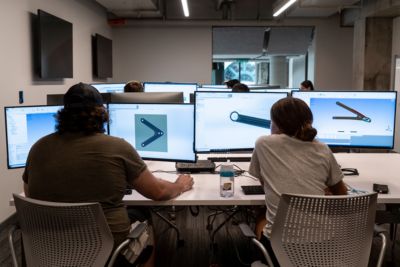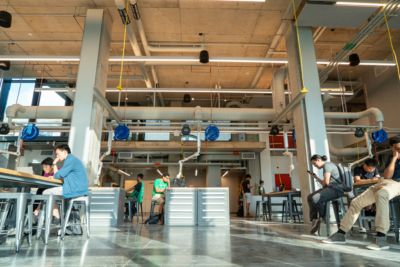-
United States -
United Kingdom -
India -
France -
Deutschland -
Italia -
日本 -
대한민국 -
中国 -
台灣
-
-
產品系列
查看所有產品Ansys致力於為當今的學生打下成功的基礎,通過向學生提供免費的模擬工程軟體。
-
Ansys Blog
October 31, 2019
Ansys Hall Prepares Carnegie Mellon Students for the Workforce
In today’s market, engineers need to graduate with hands-on knowledge to hit the ground running in the workplace. This trend has led to an explosion of extra-curricular activities, including design competitions, hackathons and maker spaces.
In response, Ansys and Carnegie Mellon University (CMU) partnered to create a space where engineering students can gain hands-on experience.
ANSYS and Carnegie Mellon University (CMU)
partner to open ANSYS Hall. Image courtesy
of Carnegie Mellon University
Ansys Hall is a 36,000-square-foot learning center. The building gives students access to:
- High-bay building areas
- Design studios
- Course work areas
- Fabrication tools
- Workshops
- A computer cluster
- Collaboration spaces
- Ansys simulation tools and technologies
Students can gain access to ANSYS simulation tools and technology
at Carnegie Mellon University’s ANSYS Hall. Image courtesy of
Carnegie Mellon University
Ansys Hall will be a focal point where CMU educators, researchers and students can embed simulation technology into various university activities. In fact, the building is already a collaborative, multidisciplinary cornerstone on campus — used by professors and students from 18 engineering courses.
The partnership is also supporting Make Possible: The Campaign for Carnegie Mellon University. This campaign aims to raise $2 billion to support CMU’s goals for its students, colleges, schools and operations as a whole.
Ansys Simulation Experience Gives CMU Students and Researchers an Edge
Ansys and CMU have had a long-standing partnership. Ansys supplies the school with the support and software CMU researchers need to overcome their engineering challenges.
In return, CMU supplies Ansys with engineering talent that has helped to grow its technology and business.
The goal of the Ansys Hall partnership is to reduce the barrier between engineers and simulation.
Simulation is still seen as a tool for academics by many in the field.
ANSYS Hall offers students the tools
and space they need to grow their
simulation knowledge. Image
courtesy of Carnegie Mellon
University
By introducing simulation to engineering students early in their careers, it will become second nature by the time they enter the workforce.
As a result, the next generation of engineers, across all disciplines, will know how simulation can pervasively improve their designs in numerous ways. They will also learn how collaborative environments focused on simulation-driven design, like Ansys Hall, can help them optimize designs to perform better with less resources.
This boost of engineering knowledge encourages pervasive simulation within product lifecycles. As a result, the next generation of engineers will create more innovative products, solutions and disruptions. It will also make students from CMU, with Ansys simulation knowledge, more attractive in the job market.
To learn how students from around the world can gain access to Ansys simulation technology, read: Ansys Free Student Software Downloads.
To learn how student design teams can gain access to Ansys simulation technology, read: Student Teams.













